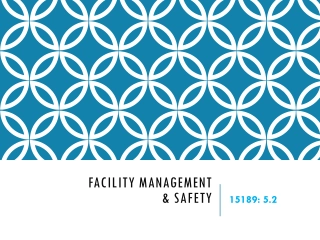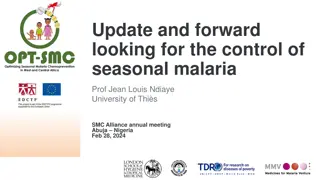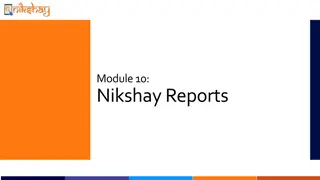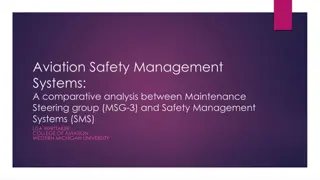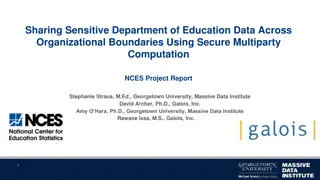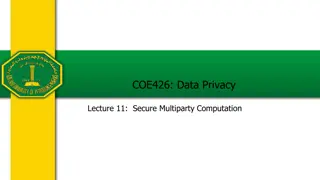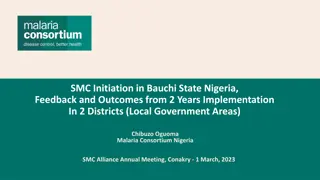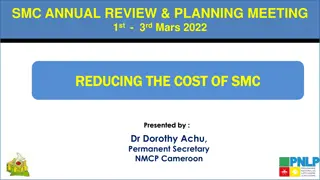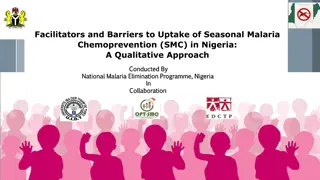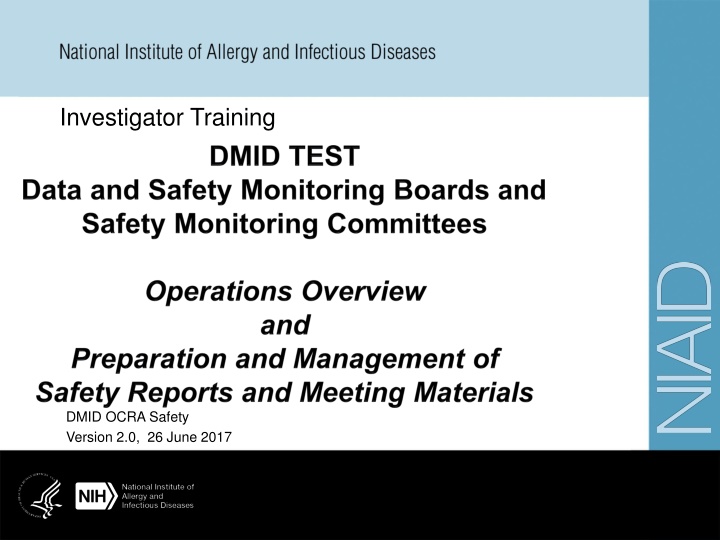
Safety Oversight in Clinical Trials: Roles and Responsibilities
This document provides an overview of the safety oversight procedures in clinical trials, focusing on the roles and responsibilities of key personnel such as the Principal Investigator, Data Coordinating Center, and Safety Monitoring Committees. It outlines the importance of safety monitoring to ensure participant safety and data integrity, as mandated by NIH and NIAID policies. Additionally, it covers the preparation and management of safety reports for DSMB/SMC meetings in compliance with DMID requirements.
Download Presentation

Please find below an Image/Link to download the presentation.
The content on the website is provided AS IS for your information and personal use only. It may not be sold, licensed, or shared on other websites without obtaining consent from the author. If you encounter any issues during the download, it is possible that the publisher has removed the file from their server.
You are allowed to download the files provided on this website for personal or commercial use, subject to the condition that they are used lawfully. All files are the property of their respective owners.
The content on the website is provided AS IS for your information and personal use only. It may not be sold, licensed, or shared on other websites without obtaining consent from the author.
E N D
Presentation Transcript
Investigator Training DMID OCRA Safety Version 2.0, 26 June 2017
Purpose Provide the Investigator and the Investigator s team with an operations overview of the Division of Microbiology and Infectious Diseases (DMID) Data and Safety Monitoring Boards (DSMBs) and Safety Monitoring Committees (SMCs). Provide guidance to the Investigator and the Investigator s team for the preparation and management of Safety Reports and materials for DSMB/SMC meetings that meet DMID requirements for format and content. 2
NIH and NIAID policy National Institutes of Health (NIH) policy requires data and safety monitoring for all NIH-supported clinical trials to ensure safety of participants and validity and integrity of data. NIH policy states this monitoring may be conducted in various ways and by various individuals or groups. National Institute of Allergy and Infectious Diseases (NIAID) utilizes Principal Investigators, NIAID program staff, Independent Safety Monitors (ISMs), SMCs, and DSMBs to perform safety monitoring. Independent data review is a crucial activity required to identify safety signals and confirm data integrity and validity. 3
Key Roles in Safety Oversight Principal and Site Investigators Data Coordinating Center (DCC) and Statistical Data Analysis Center (SDAC) Biostatistician Blinded Unblinded Safety Oversight Committee Support (SOCS) DMID Clinical Project Manager (CPM) DMID Medical Monitor (MM) DMID Medical Officer (MO), Scientific Lead (SL), and Regulatory Affairs Specialist (RAS) Independent Safety Monitor (ISM) DMID Safety Oversight Committees (DSMBs/SMCs) 4
Principal Investigator Responsible for safety reporting to the FDA if the study is being conducted under an investigator held IND. Ensures Safety Reports are prepared for DSMB/SMC meetings, when the investigator oversees Data Management and Statistical groups. Ensures study-related materials (protocol, sample informed consent form, study product information) meet DMID requirements. Attends the Open Sessions of DSMB/SMC Organizational, Data Review, Final Review Meetings and Ad Hoc Meetings when required. During the DSMB/SMC Organizational Meeting: provides overview of the study design and safety monitoring plan; responds to questions from DSMB/SMC Members During the DSMB/SMC Data Review Meetings: provides study status update, responds to questions regarding study conduct and safety events. 5
PI Presentation of Protocol for DSMB/SMC Organizational Meeting Presents overview of the protocol design, safety monitoring and halting rules using 10-15 slides to review: Background/Rationale for the Study Primary and Secondary Objectives Outcomes Measures Study Design Schematic Schedule of Events Table Safety Profile of Study Product(s) Safety Monitoring DSMB/SMC Planned Reviews Study Halting Rules/Dose Escalation Halting Rules Study Timeline (Note: CPM assists with operational questions. MM assists with questions re: safety monitoring (e.g. halting rules) and related procedures.) 6
Site Investigator(s) Responsible for safety reporting to DMID and the IRB/EC. Identifies the ISM for the Investigator s site when an ISM is required by DMID. Notifies the ISM of Serious Adverse Events (SAEs). Provides additional information upon request by DMID related to SAEs and other safety events including those events that may have met halting rules. Receives DSMB/SMC Recommendations and Meeting Minutes Submits DSMB/SMC Recommendations to the Institutional Review Board (IRB)/Ethics Committee as required. 7
Data Coordinating Center (DCC) and Statistical Data Analysis Center (SDAC) Provides the draft Safety Report Templates (Open and Closed Session) for the DSMB/SMC Organizational Meeting. Prior to DSMB/SMC Data Review Meetings: provides draft Open Session Report for review and approval by DMID CPM and MM. Provides modifications to the Safety Report as requested by DMID and/or the DSMB/SMC. Transmits Final Safety Reports (Open and Closed Sessions) to the DMID Safety Oversight Committee Support group (SOCS). Provides Ad Hoc Safety Reports as requested by DMID and/or DSMB/SMC. 8
Study (Blinded) Biostatistician Reviews draft Safety Report template during the Open Session of the DSMB/SMC Organizational Meeting. Prior to DSMB/SMC Data Review Meetings, oversees preparation of the Open Session Safety Reports. Presents Safety Report and clarifies data during Open Session of DSMB/SMC Data Review meetings Responds to questions from DSMB/SMC Members regarding Open Session report data presentations and analyses. 9
Independent Unblinded Biostatistician Presents the Closed Report in the DSMB/SMC Closed Session of the meetings. Provides the unblinded treatment assignments to the DSMB/SMC as needed in the Closed Session. FDA notes that it is advantageous for the statistician performing the interim analysis to be uninvolved in managing the conduct of the trial, especially in regard to making decisions about design modifications* *Guidance for Clinical Trial Sponsors: Establishment and Operation of Clinical Trial Data Monitoring Committees http://www.fda.gov/RegulatoryInformation/Guidances/ucm1270 69.htm 10
Safety Oversight Committee Support (SOCS) DMID contractor that facilitates DSMB/SMC meetings and related activities. Serves as the Executive Secretary for the DSMB/SMC. Facilitates and documents confidential communications. Supports the DSMB/SMC Chair with meeting conduct and documentation. Distributes final Charter, Recommendations, Minutes. Facilitates access and posts DSMB/SMC meeting materials to the secure Document Library for the DSMB/SMC and for Open Session participants. Facilitates Conflict of Interest (COI) review of Members and ISMs. 11
DMID Clinical Project Manager (CPM) Serves as primary contact for SOCS regarding logistics of meeting activities. Approves the Agenda (including who presents at the Open Sessions of Meetings). Participates in Open Sessions of DSMB/SMC Meetings as a DMID representative; provides current study status during Organizational Meeting. Assists PI with answering operational questions. Reviews and approves draft Safety Report template, draft Open Session Safety Reports, Charter, Recommendations, Open Session Meeting Minutes prior to being finalized. Reviews and approves the DSMB/SMC Recommendations and recommends actions for implementation by the study team, as applicable. 12
DMID Medical Monitor (MM) Participates in Open Sessions of DSMB/SMC Meetings as a DMID representative; assists with answering questions about safety monitoring and related procedures (e.g., review of halting rules). Reviews and approves Safety Report Templates, draft Open Session Safety Reports, Charter, and Open Session Meeting Minutes prior to being finalized. Reviews the DSMB/SMC Recommendations and recommends actions for implementation by the study team, as applicable. Reviews and evaluates ongoing safety information and consults with investigator, ISM, or DSMB/SMC Chair as needed for assessment of safety events or halting rules. 13
DMID Medical Officer (MO),Scientific Lead (SL) and Regulatory Affairs Specialist (RAS) Medical Officer (MO): Primarily responsible for protocol development, inclusion/exclusion criteria, and eligibility questions. May assist in answering questions about study design and endpoints during the Organizational Meeting. Scientific Lead (SL): Provides scientific expertise regarding the clinical development plan. May assist in answering questions about study design, objectives and endpoints during the Organizational Meeting. Regulatory Affairs Specialist (RAS): For DMID-Held INDs/IDEs only, Responsible for the management of DMID-held INDs/IDEs. Submits IND safety reports and DSMB/SMC Recommendations to the FDA. May assist in answering regulatory questions. 14
Independent Safety Monitor (ISM) Physician located at the study site with relevant expertise whose primary responsibility is to provide to DMID an independent safety assessment of Serious Adverse Events (SAEs) in a timely fashion. May be asked by DMID to examine a study participant and provide an ad hoc medical assessment. Reviews additional safety-related events at the request of DMID. Participation is for the duration of the DMID study and is a voluntary position that does not receive payment. Attends DSMB/SMC Data Review Meetings when events are discussed that occurred at his or her particular study site. 15
DMID Safety Oversight Committees DMID requires a DSMB for all randomized clinical trials of any phase that involve both investigator-masked interventions and enrollment of greater than 100 subjects. DMID utilizes another type of committee, a SMC, for many Phase I and smaller Phase II trials. DSMBs/SMCs are convened by authority of the DMID and are advisory to DMID and the study team. Members are unpaid volunteers who are independent of the trial investigators, pharmaceutical sponsor (if any) and funding agency. 16
Data and Safety Monitoring Board Members include a Biostatistician experienced in clinical trials statistical methods and Clinicians with relevant expertise. Periodically (at least annually) reviews cumulative safety and efficacy data. Approves draft Safety Report (Open and Closed) developed based on study protocol and data review requirements. Reviews the Safety Reports, Protocol, Sample Informed Consent Form, Study Product information, Charter, and other pertinent documents related to trial oversight. Based on data review, recommends continuation of the study without change, continuation with change, or termination of the study. 17
Safety Monitoring Committee (SMC) Responsible for reviewing cumulative safety data during the course of the clinical trial. Approves draft Safety Report (Open and Closed) developed based on study protocol and data review requirements. Reviews the Safety Reports, Protocol, Sample Informed Consent Form, Study Product information, Charter, and other pertinent documents related to clinical trial oversight. Based on data review, recommends continuation of the study without change, continuation with change, or termination of the study. 18
Meeting Types Organizational Meeting Data Review Meeting (DRM) Ad Hoc Meeting Final Data Review Meeting 19
Organizational Meeting Initial meeting of the DSMB/SMC held prior to any participant enrollment. The Members will: Review the Protocol, sample Informed Consent Form, Study Product Information (e.g., Investigator s Brochure and/or package insert) and draft Charter. Review and approve the halting rules and planned safety monitoring for the study. Establish a meeting schedule including the estimated duration of safety oversight activities. Finalize format, content and protocol-specified statistical methods to be used in Safety Reports (Open and Closed) to be considered by the DSMB/SMC. 20
Data Review Meeting Purpose is to evaluate safety and study conduct; the study may be stopped because of significant safety concerns. Emerging efficacy data may be considered by the DSMB/SMC when evaluating the potential risks and benefits of the intervention under study. Includes Open and Closed Sessions. Note: DMID staff do not attend Closed Sessions. However an exception may be made by the Division Director in very special circumstances. DSMB/SMC Members must be notified in advance if a Medical Officer or Medical Monitor is authorized to attend the Closed Session. 21
Ad Hoc Meeting An unplanned meeting that is convened for a specific purpose such as when a study halting rule is met. The meeting may be requested by any party with the responsibility of overseeing the trial such as the PI, ISM, DSMB/SMC, DMID, Industry Collaborator. Special reports may be requested for this meeting on an as-needed basis. The DSMB/SMC Chair, in collaboration with DMID and SOCS, will schedule any unplanned meetings. DMID determines who should attend the meeting. 22
Final Data Review Meeting End of study meeting that occurs 6 to 8 months after clinical database lock to review cumulative unblinded safety data. Data will be provided in a standard summary format. DSMB/SMC may be asked to provide recommendations in response to questions posed by DMID. Sometimes it may not be practical to ask Members to serve for many years due to long-term follow up, so may meet to review safety data only while participants are receiving treatment. 23
DSMB/SMC Meeting Conduct Open Session Closed Session Closed Executive Session Communications DSMB/SMC Recommendations DSMB/SMC Open Session Meeting Summary 24
Open Session of DSMB/SMC Meetings Focuses on the general conduct and progress of the study. Is attended by the Protocol Team, Coordinating/Data Center staff, DMID staff, Representatives of Collaborators (industry or other government agencies). Open Session Report must be blinded, the data are presented in aggregate and must not include comparative data by treatment group. When treatment assignments are blinded, no information should be discussed that could potentially unblind the study team to treatment assignments. 25
Closed Session of DSMB/SMC Meetings Attended only by the DSMB/SMC Members, independent unblinded biostatistician, and Executive Secretary (SOCS). Allows discussion of confidential grouped data from the clinical trial, including information about the relative efficacy and safety of interventions. Consultants may be invited by the DSMB/SMC to provide expertise during this session. Note: DMID staff do not attend Closed Sessions. However an exception may be made by the Division Director in very special circumstances. DSMB/SMC Members must be notified in advance if a Medical Officer or Medical Monitor is authorized to attend the Closed Session. 26
Closed Executive Session of DSMB/SMC Meetings Closed Executive Session is attended only by the DSMB/SMC Members and SOCS for confidential deliberations to review unblinded safety data, discuss findings, and develop consensus on recommendations on its list of recommendations, including whether the trial should continue, be modified or terminated. DSMB/SMCMembers should attempt to reach consensus; however, if consensus is not reached, each recommendation will be considered by the DMID representatives- DMID MM and CPM. 27
Proper Communications The Investigator communicates with the CPM and MM at DMID. The Investigator and study team members do not communicate directly with the DSMB/SMC Members outside of the meetings. All communications are between only DMID and DSMB/SMC Members, these are sent via the SOCS group to ensure they are formally documented. There may be circumstances when the DMID MM and/or CPM will have a discussion, or share information with the DSMB/SMC, that is otherwise not specifically prescribed in the communication plan in the Charter. 28
DSMB/SMC Recommendations DSMB/SMC recommends if the study should proceed as planned, be modified, or terminated. After the Closed Session, the Chair provides verbal recommendations to the DMID MM and CPM. SOCS provides a written summary of the Recommendations to the Chair for approval within one business day. After approval by the Chair, the DMID MM and CPM review the Recommendations and may include additional action items for implementation, as needed. If the decision is made not to implement a Recommendation, a rationale must be provided to the DSMB/SMC. Written Formal Recommendations are distributed within 3 working days by SOCS and posted to the Document Library. 29
DSMB/SMC Open Session Meeting Summary SOCS prepares draft Open Session Meeting Minutes which describe proceedings, including DSMB/SMC Recommendations and any action items. Draft Meeting Minutes are sent to DMID MM and CPM for review within 5 business days of approved Recommendations. After approval by DMID, the Minutes are sent to the Chair for review and approval. Final Open Session Minutes should be made available within 30 calendar days of the Meeting and are distributed by SOCS. 30
DSMB/SMC Meeting Materials List Includes but not limited to: Agenda Contact List (individuals with a role in the meetings) Protocol Sample Informed Consent Form (ICF) Study Product Information Charter (draft for the Organizational Meeting) DSMB/SMC Safety Report (shells for Org Meeting) SAE line listing/narratives from CROMS Pharmacovigilance (PVG) group (DMID contractor that receives and processes SAE reports) 31
Access to Meeting Materials SOCS facilitates access and posts DSMB/SMC meeting materials to the secure Document Library for the DSMB/SMC Members and for Open Session participants according to the Contact List. SOCS sends email notification with the date and time of the scheduled meetings. SOCS sends email notification that the Safety Report and related meeting materials are available for access on the website. In urgent situations, SOCS may use password- protected email to send review materials directly to the DSMB/SMC Members. 32
SOCS Email Notification Safety Report/Review Materials Posted To access the DMID-CROMS Document Library: Go to https://www.dmidcroms.com Log in using the username and password previously sent to you by the DMID-CROMS Web Administrator. 33
Types of DSMB/SMC Safety Reports Types of reports: Open Session Report Closed Session Report Ad Hoc Report ISM Assessment and Report 34
DSMB/SMC Safety Reports: Overview of Content and Format Report Contents: Summary of study and findings in data Listings Tables Graphical presentations of data (grafts/figures) Event Narratives as indicated. Report format should be user friendly Acceptable formats include single, unique MS Word, MS Excel, or Adobe PDF files. If multiple files are required, combine to minimize the number of files for downloading and review. Indexed zip (compressed) files are not acceptable. 35
Open Session Report: Overview Data are presented in aggregate and does not include comparative data by treatment group. Summarizes the design and progress of the study, includes statistical commentary explaining issues presented in the Open Report figures and tables. Provides information on study conduct such as: Recruitment and baseline characteristics Adverse events Eligibility violations Study status Completeness of follow-up and compliance 36
Open Session Report: Components One page outline of study design with scheme Study timeline with milestones, summary of any major protocol changes, discuss if study halted Summary of previous DSMB/SMC reviews including recommendations /actions Explanation of any issues presented in Open Session report figures and tables Data are displayed in aggregate and not displayed by treatment group Number randomized, withdrawn, reasons for withdrawal, discontinuations, reason for discontinuation Subject screening, reasons for screening failures 37
Open Session Report: Components (cont.) Eligibility and protocol violations. Demography and baseline characteristics labs, disease characteristics, medical history Adherence to dosing schedule, attendance at scheduled visits Reporting delays in key events Length of follow-up data available Safety information is displayed as aggregate data for AEs/SAEs, AEs leading to withdrawal/dosing changes, deaths. 38
Closed Session Report: Overview Detailed statistical commentary describing an overview of the key findings and explaining issues raised by the Closed Session Report figures and tables. Closed Session Report data displayed treatment groups reviewed in the closed session only. Open Session Report data may also be included and presented separately for each study arm. Includes: Study outcomes Safety data Efficacy data (DSMB) 39
Closed Session Report: Components Executive summary of report and detailed statistical commentary explaining issues in Closed Report Repeat of Open Report information in greater detail and data is displayed by treatment groups Study endpoints are represented in tables, figures, or graphs as appropriate. Tables relate to formal interim analyses for efficacy or futility, analyses of primary and secondary endpoints Summary of AEs/SAEs, AEs leading to withdrawal or dosing changes, deaths. Comparison of groups to determine if there is an increased occurrence or AEs or serious suspected adverse reactions. 40
Closed Session Report: Components (cont.) AEs by SOC and Preferred Term, by severity/grade, product related SAEs by SOC and Preferred Term Separate and more up to date SAE listing and SAE narratives listed by subject ID from PVG Summary of Deaths Laboratory Data and Summary Statistics Laboratory Data and Shift tables 41
DSMB Reports Checklist 1.OPEN SESSION REPORT- AGGREGATE DATA AND NOT GROUPED BY TX One page outline of study design with scheme Study timeline with milestones and summary of any major protocol changes, discuss if study halted Summary previous DSMB reviews: date of review, date of data for report, recommendations /actions Explanation of any issues presented in Open report figures and tables Data is aggregate and not grouped Number randomized, withdrawn, reasons for withdrawal, discontinuations, reason for dc Subject screening, reasons for failures Eligibility and protocol violations Demography and baseline characteristics labs, disease characteristics, medical history, tx history Adherence to dosing schedule, attendance at scheduled visits Reporting delays in key events Length of follow-up data available Safety information , efficacy aggregate data and analysis 2.CLOSED SESSION REPORT TEMPLATE GROUPED DATA BY TX Executive summary of report and detailed statistical commentary explaining issues in Closed Report Repeat of Open report information in greater detail by treatment group Study endpoints are represented in tables, figures or graphs as appropriate. Tables relate to formal interim analyses for efficacy or futility, analyses of primary and secondary endpoints Summary of AEs/SAEs, AEs leading to withdrawal/dosing changes, deaths AEs by SOC and preferred term, by severity/grade, product related SAEs by SOC and preferred term Separate and more up to date SAE listing and SAE narratives listed by subject ID Summary of deaths Laboratory data and summary statistics Laboratory Data and Shift tables 42
Ad Hoc Reports: Overview DSMB/SMC may request special reports on an as- needed basis. Requests are made to DMID, the Unblinded Statistician participating in the Closed Session, or SOCS, as appropriate. MM/CPM may request certain information to assess an event. Ad Hoc Reports are provided to the DSMB/SMC through SOCS. Specific question(s) are posed to the DSMB/SMC for recommendation based on the report(s) provided. 43
ISM Assessment and Report Receives reports of Serious Adverse Events (SAEs) from the site investigator and by email from SOCS when DMID is notified of SAEs. Immediately evaluates the SAE and provides a clinical assessment to DMID by emailing SOCS an ISM report (ISM report template is in the charter). Indicates if a DSMB/SMC Ad Hoc meeting is recommended as part of the ISM assessment. Communicates with the site investigator as needed. Reviews other safety events at the request of DMID. Provides additional information to DMID and/or the DSMB/SMC by teleconference as requested. 44
Some Lessons Learned with DSMBs/SMCs In the protocol, specify what should trigger a DSMB/SMC review. The purpose of the review should be clear and define what question(s) are being asked of the DSMB/SMC. The types of data that are presented to DSMBs/SMCs and the way these data are presented are crucial to meaningful guidance and recommendations. DSMBs/SMCs really are independent and their recommendations cannot always be anticipated. Investigators and sponsor staff need to be prepared as much as possible before DSMB reviews to respond expeditiously to their recommendations. 45
Some Lessons Learned with DSMBs/SMCs (cont.) Be mindful of study timelines! A data center with extensive experience preparing reports for DSMB/SMC meetings is likely to know how to prepare them for a new trial. In contrast, staff without such experience will need considerable guidance (from the sponsor or a consultant), as well as extra time to prepare shell reports proposed specific tables and figures for review and comment by the DSMB/SMC during the Organizational Meeting. Schedule sufficient time to work with data groups and statisticians, and provide the DSMB/SMC with adequate time to carefully consider the data that have been collected. 46
Lessons Learned with DSMBs/SMCs (cont.) Summarize data in user-friendly ways that answer the specific questions that are being posed to the DSMB/SMC. Presenting inadequate data can cause delays and the need for subsequent meetings. Display safety information in the context of what the expected background rates are for the population under study, so that it is clear whether what is being observed is at an elevated frequency or severity. Prior to the scheduled DSMB/SMC meeting, it is essential to assemble as much ancillary information as possible concerning any potential safety issues that may have arisen. 47
Timelines Study Timeline DSMB/SMC Organizational Meeting Timeline DSMB/SMC Data Review Meeting Timeline 48
Study Timeline - Milestones DSMB/SMC activities in relationship to study timeline: Study synopsis and protocol development DSMB/SMC Members and ISM(s) identified Organizational Meeting Study Start (enrollment begins) Study Implementation (Data Review Meetings/Ad Hoc Meetings) End of Study Database Lock Final Safety Data Review Meeting End of Service (with SOCS and the Committee Members) Final Clinical Study Report (CSR) 49
Organizational Meeting Safety Report: Timeline Prepare draft Safety Report Template (Open and Closed). Draft Safety Report (Open and Closed) to DMID for review 10 business days prior to meeting. DMID review and comment complete within 3 business days after receipt. Within 2 business days, DCC revisions, approval by DMID and transmit Final Safety Report Template (Open and Closed) to SOCS for posting on secure website (no later than 5 business days prior to meeting). 50

